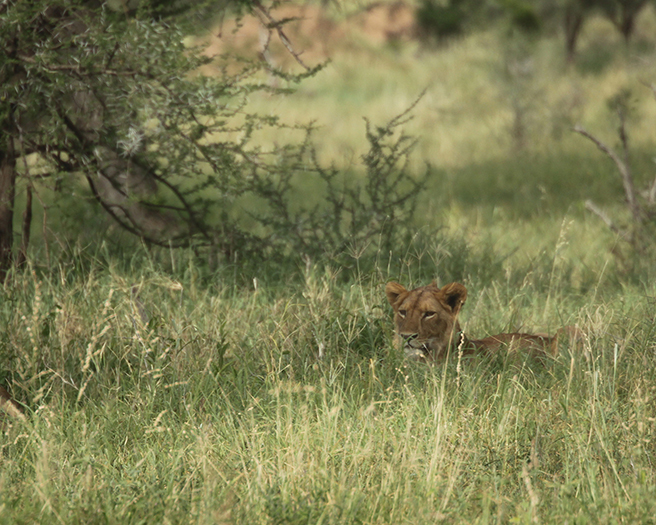Arrival and Tarangire

Let’s just say I’m really glad I’m short and leave it at that, because I can’t imagine being tall and taking such a long flight in such a small seat. But as with all amazing journeys – and trust me, this trip was the very definition of amazing – all the rigors of travel were forgotten when we landed at last at Kilimanjaro International Airport in Arusha, Tanzania. Just the words sound magical, and that’s another very accurate way to describe our trip, as you’ll see.
It didn’t take Polly and me long to make it through Customs and head out to find our bags, where we met the first of our fellow safari-goers, D. She recognized my picture from this blog and introduced herself. Like everyone in the group, she was easy to talk to and a great traveling companion. But then, we were all there for love of Africa and animals, and because we support everything AWF does, and with that much in common, how could we not find lots to talk about?
Baggage collected, we headed for the main hall of the airport (which was much smaller than I ever would have expected), and there were our fearless tour leader and his equally fearless “co-captain,” AWF’s Stephen and Amy. Stephen was making his 27th (or thereabouts) trip to Africa, while Amy had been to Africa before but was on her first safari, and they proved to be wonderful company and excellent caretakers. For example, I live on Diet Coke but was perfectly willing to drink the high-octane regular version on safari, but Stephen not only made sure the nyumbas stocked lots (and lots and lots) of Coke, I’m pretty sure that it’s thanks to him that Coke Light started showing up at the bar.
Most of our group had come in on the same flight – one woman, P, had come in a day early, and a couple, R and D, were delayed by a lost passport – so once everyone was in the bus we were off to Rivertrees, a relaxing lodge set – surprise! – right by a river. We had a quick welcome briefing – and a snack – and then we were guided to our cottages so we could collapse. We only spent two nights total in lodges, but I have to say, they were both wonderful, really spacious and comfortable, and the settings were gorgeous. Rivertrees has resident monkeys, so of course I had to go out looking for them when I got up the next morning. The colobus refused to appear for me and the vervets were nowhere to be seen (though we saw plenty of them later), but I did see the blue monkeys (who are not really blue, sadly) and got a couple of really, really bad photos. Since there’s only room to include a few photos per blog entry, I won’t be wasting one so you can look at a tree and wonder where the monkey is.
After breakfast we climbed into the Rovers we would come to know well over the next ten days, made a quick stop at the Cultural Center in Arusha to scope out the things we might want to come back for on the last day and then headed for Tarangire, our first park.
We got to the main gate by lunch and set up with our boxed lunches (courtesy of Rivertrees) at a concrete picnic table and prepared for two things: a conversation with Dr. Bernard Kissui, who’s in charge of AWF’s Tarangire Lion Project and two of his assistants, and an onslaught by very mischievous, very clever and very speedy vervet monkeys. One snatched half of Amy’s sandwich right out of her hand as she stood listening, and another actually jumped up on the table to steal a granola bar from L, another safari-goer. But as fun as the monkeys were, Dr. Kissui was the real highlight.
He and his staff keep track of the lion population in the park – which includes the use of both GPS and radio collars – monitoring not only the numbers and ranges of the lions but also working to minimize lion-human conflicts, since the lions frequently migrate outside the park to look for prey, and when that prey is domestic animals instead of wild ones, the lions’ survival is put at risk. One solution? Predator-proof chain link bomas to keep the local human population and their herds safe. Because the weather had been dry (which was also delaying the wildebeest calving season), he said the lions had been moving out of the park lately, so we shouldn’t count on seeing any in Tarangire. And then, lunch finished, it was time to get back in the Rovers and head into the park, looking for wildlife as we headed for our nyumba, the tent camp where we would be spending the next several nights.
This is as good a time as any to mention what Stephen dubbed the “Leslie luck.” I think the phrase first came up on our last night in Tarangire, when he invoked it in hopes of seeing rhino. But it started with me winning such a incredible prize and started showing itself right away once we entered the park.